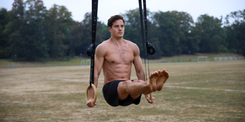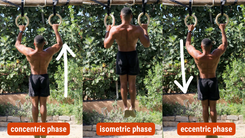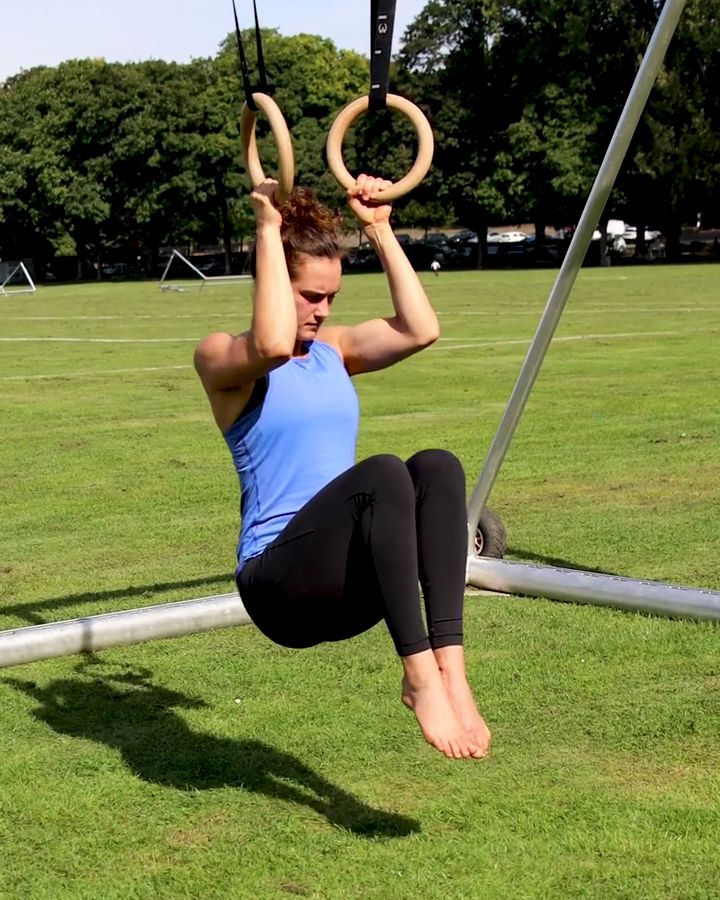What is Concentric and Eccentric Muscle Training?

Three Different Movement Phases: Eccentric, Isometric, and Concentric in Training
In training, most athletes focus primarily on the concentric phase or concentric training. During this phase, the target muscle contracts as you, for example, lift a weight. In the so-called static phase, you stop moving and hold tension in the muscle. Finally, there’s the often-overlooked eccentric phase. Here, the previously contracted target muscle lengthens again as you return to the starting position.
Eccentric training, also known as negative repetitions, has the potential to revolutionize your workouts. This article will explain why the eccentric phase, alongside the concentric phase, is essential for effective training.

The Three Movement Phases at a Glance
Concentric Phase
- The muscle contracts, actively working against resistance.
- Example: Pulling yourself up during a pull-up.
Isometric Phase
- The muscle holds tension without shortening or lengthening.
- Example: Holding the top position of a pull-up.
Eccentric Phase
- The muscle lengthens while actively working to slow the movement.
- Example: Lowering yourself in a controlled manner during a pull-up.

Why the Eccentric Phase is Often Underestimated
Many athletes focus solely on the concentric part of an exercise, counting repetitions only when they successfully complete the concentric phase. This often leads to neglecting the eccentric phase, such as lowering themselves back to a hang position during a pull-up.
However, new insights into how muscles work during the different movement phases can help you make your training more effective.
Benefits of Eccentric Training
During eccentric muscle contraction, the muscle lengthens under resistance as it works to slow the movement.
In everyday training, this phase is frequently performed too quickly. For example, in a pull-up, many people drop to the starting position without control. Since the muscle doesn’t need to exert force to slow the movement, it conserves energy for the next concentric repetition.
At first glance, this might seem like a good idea—after all, saving energy might allow you to complete one more pull-up. Or does it?
Why is the Eccentric Phase So Important in Muscle Training, and Why Shouldn’t You Skip It?
Studies have shown that during the eccentric phase, you are up to 40% stronger than during the concentric phase! This is because the eccentric phase stimulates more muscle fibers than the concentric phase. Skipping a controlled eccentric phase reduces muscle activation with each repetition, thereby limiting the growth stimuli needed for muscle development.
It’s far more beneficial to execute each repetition as cleanly as possible, rather than saving energy to complete additional incomplete reps.
How Eccentric Training Benefits Your Workouts
Learn New Exercises with Negative Repetitions
Exercises that are too challenging concentrically can be mastered by starting with the eccentric movement. Since you are stronger during the eccentric phase, this approach allows you to build the strength and muscle required for the concentric phase. At the same time, you’ll develop the neuromuscular coordination needed to perform the exercise correctly.
Example: Negative pull-ups are an excellent way to build the strength and coordination necessary for a full pull-up.
Negative Chin Ups
Negative pull-ups are one of the most important exercises on the journey to achieving a full pull-up. The focus here is on controlled lowering.
Necessary equipment
Concentrate on the eccentric phase of the movement.
- Start in a hang with your feet on the ground
- Retract your shoulder blades downwards and backwards
- Pull the rings up to your chest
- Use your legs as much as necessary to assist you on the way up
- Lift your legs in the top position
- Pause briefly before you start to lower yourself
- Lower yourself slowly and controlled back to the starting position
- Lower yourself until your arms are fully extended
- Maintain control over the negative phase, which is the lowering part
- Ensure that your movements are smooth and controlled
Your Comeback Strategy: Regain Strength with Eccentric Training
We’ve all been there—you’re in top form, and then an injury sets you back. Don’t worry! With the right strategy, you can successfully return to training.
Eccentric training is a powerful tool that can help you regain control over your movements. After a long break due to injury, eccentric muscle contraction allows you to gradually rebuild your muscles and support structures.
This method has proven highly effective not only in rehabilitation but also in pain therapy, making it an essential part of recovery-focused training.
Mastering Eccentric Training: Unlock Its Full Potential
You’ve realized that the eccentric phase is invaluable—not only for building strength and muscle but also for improving the resilience of your tendons, ligaments, and joints. To make the most of these benefits in your training, keep the following tips in mind:
- Control is Key. Perform the eccentric phase at a pace where you can stop the movement at any time. Focus on slowing down the motion. For example, during a pull-up, aim for 3–4 seconds when lowering yourself.
- Use the Full Range of Motion. Stretch your target muscle as much as possible throughout the movement. This ensures maximum mobility and efficiency in your training.
- Start Gradually with Negative Repetitions. When using bodyweight exercises to learn new skills, practice in moderation. Progress slowly and avoid overexertion.
With these simple adjustments, you can optimize the eccentric phase for your training. The DIE RINGE App incorporates eccentric training directly into your workout plans, helping you master advanced skills like Skin the Cat or the Front Lever sustainably.
DIE RINGE APP: Learn Calisthenics Skills Step by Step
Achieve your goals with structured plans that adapt to your progress.
With over 700 exercises, we ensure you always have the right progression tailored to your needs.
Calisthenics Training: Designed by Sports Scientists, Optimized by Smart Algorithms
Experience your best workout yet with a system built for results.

Stay Motivated
We make it easy to turn your training into a habit—thanks to encouraging features and a well-structured training plan.
Personalized Training Plan
We combine cutting-edge technology with sports science to tailor your training, ensuring you progress at the perfect level and optimal pace.
Connect with Real People
Simply shake the app to share feedback or get support—we’re here to help you improve the app and assist you with your training!
Developed by Sports Scientists
By combining research-backed training methods with effective exercises, we create training plans designed to help you successfully build strength and muscle.

Stay Motivated
We make it easy to turn your training into a habit—thanks to encouraging features and a well-structured training plan.

Personalized Training Plan
We combine cutting-edge technology with sports science to tailor your training, ensuring you progress at the perfect level and optimal pace.

Connect with Real People
Simply shake the app to share feedback or get support—we’re here to help you improve the app and assist you with your training!

Developed by Sports Scientists
By combining research-backed training methods with effective exercises, we create training plans designed to help you successfully build strength and muscle.

~e5724973d14549c23ea8a586b5736b36.png?alt=media)